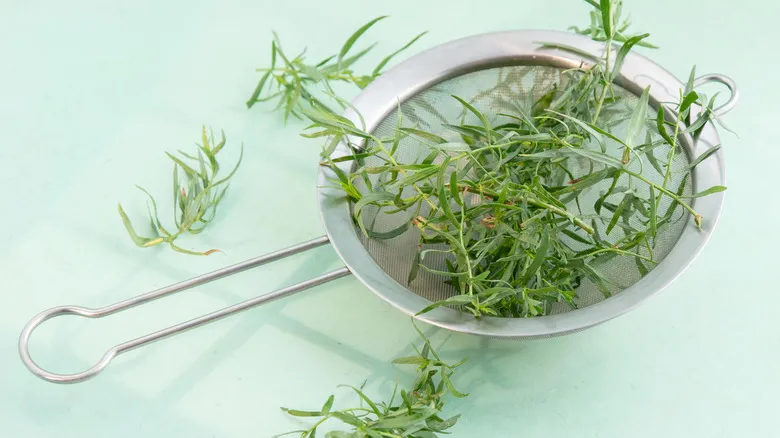Slow cook on low heat

Cooking fish at high temperatures can produce a potent, lingering fishy scent that many people find unappealing. Chef Barton Seaver explains that when fish is subjected to high heat, "fat and moisture are released from the fish, come into contact with a hot pan or oil, vaporize, and then rise into the air," resulting in a strong odor. This issue goes beyond just smell — it also affects the fish's flavor. The way something smells significantly influences its taste. When fish is cooked at high temperatures, the intense aroma amplifies the fishy taste, which can be off-putting.
A great way to mitigate this is by slow-cooking your fish at a lower temperature. This technique minimizes the release of strong odors and, consequently, the overpowering flavor. According to Seaver, with slow roasting at low heat, "you're not generating particulates that enter the air, which would create the smell we're trying to avoid." He adds, "In my kitchen, I primarily use my toaster oven to prepare most of my fish. It's simple, convenient, and quick, while also being low-stress." Alternatively, poaching fish on the stovetop provides similar advantages, preserving moisture while avoiding strong aromas. By opting for slow cooking, you not only manage the smell but also improve the overall texture and flavor, making it an ideal method for anyone wanting to enjoy seafood without the overwhelming fishy taste.
Cook with shallots

When it comes to achieving a harmonious balance of flavors in seafood dishes, shallots can be an invaluable ally. Their delicate sweetness and mild onion flavor introduce a layer of complexity without overpowering the fish. Chef Barton Seaver frequently includes shallots in his seafood recipes, stating, "I often create a sauce with finely diced shallots to add a hint of texture and a touch of crunch, which brings succulence and contrast."
The charm of shallots lies in their adaptability. They can be sautéed to enhance their natural sweetness or used raw for a sharper flavor, depending on the dish's requirements. When cooked, shallots soften and caramelize, imparting a gentle depth that complements fish beautifully. This quality can help mask any residual fishiness, making the dish more appealing to those who might be hesitant about stronger seafood flavors. Beyond their taste, shallots also enhance the dish's aroma, creating a more inviting scent that can offset any fishy odors. Combining shallots with other ingredients like herbs, butter, or wine can result in a rich, complex sauce that elevates the fish without overshadowing it. Even if you don't typically use shallots, experimenting with them in seafood dishes might offer you a refreshing perspective.
Use vinegar

Vinegar is a vital ingredient in the kitchen, especially for balancing bold flavors, and fish is no exception. Its acidity not only enhances dishes but also helps to counteract the fishy aroma and taste that some may find unappealing. "The odor associated with fish is due to their biological makeup," explains Terri Dien. "Fish utilize specific amino acids to regulate salt concentrations in their cells. Once the fish is killed, bacteria and enzymes transform these amino acids into compounds that emit that 'fishy' scent." This is where vinegar comes into play. Dien notes that vinegar, as an acidic component, causes the compounds in the fish to "bind with water instead of the amino acids, making them less volatile." This diminishes the flavor's intensity, resulting in a more enjoyable fish dish. Whether you opt to marinate the fish in vinegar prior to cooking or add it to a sauce, the outcome is a dish with a more harmonious and less overpowering flavor.
Using vinegar in your cooking doesn’t mean your dish will have a sour taste. In fact, the acidity can enhance the fish's natural flavors while keeping the fishiness at bay. You can select various types of vinegar based on the dish — white wine vinegar for a light, subtle flavor, balsamic for a deeper, sweeter note, or rice vinegar for an Asian-inspired flair. No matter your choice, it's an excellent method to mitigate the fishy taste in your seafood.
Add lemon

Lemon is a popular pairing with seafood for a good reason. Its bright acidity cuts through the richness of fish, providing a refreshing balance to the dish. Barton Seaver notes that the higher the fat content in the fish, the more pronounced its "fishy" flavor will be. "Acidic elements are what temper fat, bringing it into harmony and adding some punctuation." This is precisely why lemon complements seafood so effectively. The acidity of lemon juice not only balances the fat but also helps neutralize the strong taste. Additionally, when lemon juice is applied to fish, it begins to "cook" it slightly, breaking down proteins and softening the more intense flavors. This results in a noticeably lighter taste, which can be beneficial if you're still getting accustomed to seafood.
It's not just lemon juice that proves useful; lemon zest can also impart a burst of fresh, citrusy flavor without increasing acidity. Terri Dien mentions that one of her favorite marinades consists of "lemon juice and zest, thyme, olive oil, and a small dollop of mustard for a classic French flavor." This blend not only reduces the fishiness but also enhances the seafood's natural flavors, resulting in a dish that is both balanced and vibrant. Moreover, there are numerous delicious lemon-infused fish recipes available, so you don’t have to worry about figuring out how to incorporate lemon into your seafood dishes on your own.
Marinate with tomato

Tomatoes serve a purpose beyond being a mere salad component. You may not realize that they act as a hidden ally in reducing the fishy flavor often associated with seafood. The acidity found in tomatoes, similar to that in lemons and vinegar, aids in breaking down the compounds that contribute to the strong odor and taste that some people find off-putting. As Terri Dien points out, marinating fish in acidic-based mixtures like tomato can significantly lessen the fishiness. This technique not only boosts the flavor but also tenderizes the fish by loosening its muscle fibers, resulting in a more succulent and enjoyable dish.
A tomato-based marinade can range from simple to intricate, depending on your preference. Terri Dean advocates for this method and highlights how marinades can enhance various cuisines. "I like to marinate my fish with lemon zest, cherry tomatoes, kalamata olives (along with a bit of their brine), and chopped parsley." Another option is to mix chopped tomatoes with olive oil, garlic, and basil. Whichever tomato-based marinade you opt for, be sure to let the fish soak in it for at least 30 minutes before cooking, allowing the flavors to blend and the acidity to do its work. The outcome is a dish with a milder, less fishy flavor profile.
Add tarragon

Tarragon often goes unnoticed in many kitchens, yet it proves to be a valuable herb for masking fishy tastes in certain seafood dishes. Chef Barton Seaver particularly highlights herbs with "high, piercing aromatics," such as tarragon, for seafood cooking. With its unique combination of licorice and sweet fennel notes, tarragon is particularly effective, especially when dealing with richer, oilier fish like salmon or mackerel, where the natural fats can be quite strong. In these cases, tarragon cuts through the richness, adding a fresh, sharp element that enhances the overall flavor.
Additionally, tarragon's adaptability makes it a fantastic choice for a variety of seafood preparations. Whether in a light sauce or a creamy marinade, tarragon can enrich a dish while harmonizing with the seafood's natural taste. Its subtle sweetness also helps to balance out any acidic components you might incorporate, resulting in a more cohesive dining experience. If you enjoy oregano, tarragon can serve as a suitable substitute for basil when needed—just remember that its flavor is more intense, so you'll want to use less tarragon than you would basil.
Add chervil

Chervil is an herb from the parsley family, recognized for its delicate, feathery leaves. It is a key component of the traditional French herb blend known as fines herbes. While chervil is more commonly found in French cuisine than in American dishes, Barton Seaver considers it a hidden treasure, particularly for seafood preparations. He describes chervil as a "soft, tender herb with an elegant flavor," making it an ideal choice for balancing out strong, fishy tastes. Despite its gentle nature, chervil offers a subtle sweetness and a light hint of anise, which can complement a variety of fish flavors beautifully.
Another reason to give chervil more recognition is its versatility in adapting to different flavor profiles. Whether you're preparing a light fish soup, a seafood salad, or a simple grilled fillet, incorporating chervil can elevate the dish. Its tender leaves are best enjoyed fresh, either sprinkled on top of the finished meal or stirred in just before serving to maintain their delicate flavor. If you're eager to explore new flavors in your seafood dishes and soften any fishy notes, chervil is a fantastic herb to try.
Add mint

Mint may not be the first herb that springs to mind for seafood dishes, but it’s a remarkably effective way to enhance and balance the flavors of fish. Barton Seaver points out that mint functions similarly to acid, as it highlights the natural flavors of whatever it accompanies. Just a few sprigs of mint, with the leaves torn into small pieces and sprinkled on top just before serving, create a delightful aroma that pairs beautifully with seafood. This makes mint an unexpectedly perfect addition to many seafood recipes. The cool, refreshing essence of mint can cut through the richness of fatty fish, much like a squeeze of lemon, adding brightness and a layer of complexity.
Following Seaver's advice, you can simply tear a few fresh leaves and scatter them over a seafood dish right before serving. Alternatively, you can incorporate it into a sauce or marinade, allowing its cooling and aromatic properties to infuse the dish more thoroughly and provide a pleasing contrast. Mint works especially well in Mediterranean-inspired recipes, where it can elevate the flavors of ingredients like lemon, garlic, and olive oil. It can also be easily included in a tasty seafood salad, delivering a burst of flavor that perfectly complements the other components.
Include a creamy element

Adding a creamy component to seafood dishes can significantly alter the overall flavor profile, especially when trying to soften a strong taste. Barton Seaver suggests that "anything creamy tends to be beneficial, as it complements the fish." Creaminess effectively reduces the fishy flavor of seafood, resulting in a more balanced dish. However, Seaver warns against excessive richness, stating, "You don't want to overdo it in terms of fat on fat." The goal is to achieve the right equilibrium, where the creaminess enhances the dish without overpowering the fish.
A fantastic way to introduce creaminess is through risotto. "The creaminess and starchiness of the rice are excellent for mellowing the bold flavors of seafood," Seaver explains. While a creamy risotto pairs well with any seafood, it is particularly effective with richer, fattier fish, helping to mask any fishiness. Another option is to use ingredients like coconut milk, which Terri Dien recommends for marinating Asian-inspired seafood dishes. She enjoys the combination of lime juice and zest, fresh chiles, cilantro, and coconut milk. Ultimately, the right creamy addition can elevate your seafood meal, making it a more pleasant experience for those who are sensitive to strong fish flavors.
Include a smoky element

Incorporating a smoky element into seafood dishes is an excellent way to balance the bold flavors of fish. It's no surprise that smoked fish enjoys such popularity. Barton Seaver notes that fatty fish pair exceptionally well with smoke. "That's why we smoke mackerel, trout, and salmon," he explains. The smokiness enhances the fish, softening its rich flavors and creating a more nuanced taste experience. However, you don't need to confine yourself to smoking the fish itself, which can be a labor-intensive process requiring specialized equipment. Seaver recommends adding smoky ingredients, such as smoked sweet paprika, to achieve a similar effect.
There are numerous ways to infuse smokiness into your seafood dishes beyond smoked paprika. You can experiment with other smoked spices like chipotle or cumin, incorporate a few drops of liquid smoke into a marinade, or even grill the fish lightly to impart a smoky flavor. This approach allows you to enjoy that delightful smoky taste without the complexities of smoking the fish from scratch. Each method offers its own distinct flair, giving you the opportunity to experiment and discover the ideal smoky enhancement for various seafood dishes.
Remove the skin

The natural oils found in fish skin often contribute to a fishy flavor, which can deter some individuals from fully appreciating fish. As Terri Dien highlights, "Oily fish such as salmon or mackerel tend to have a stronger aroma compared to white-fleshed varieties like tilapia and cod." To lessen the fishiness of white-fleshed fish, you can simply remove the skin before cooking. This straightforward method effectively reduces the potent flavors associated with these oils.
Barton Seaver also mentions that "the skin, when left on a piece of fish—whether it's slow-roasted or poached—will be soft and have a gelatinous, mouth-coating texture. That might not appeal to everyone." Therefore, by taking off the skin, you not only diminish the fishy taste but also eliminate the undesirable texture that many find unpalatable.
Recommended

How To Easily Turn A Stainless Steel Skillet Into Nonstick Pan

The Best Way To Serve Hot Chocolate To A Crowd Is Too Easy

Why Michael Voltaggio Calls The French Laundry Cookbook His Favorite Cookbook Of All Time

Worth The Hype Or Overpriced: Do You Need A Home Deli Slicer?
Next up

